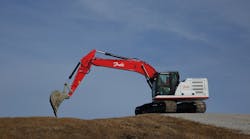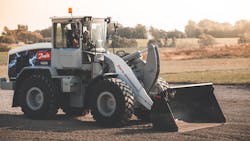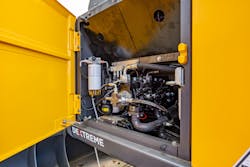Danfoss has released a whitepaper outlining methods for reducing emissions from cities to help achieve global climate goals. According to the company, a key way to do so is to reduce the emissions produced by heavy vehicles such as construction equipment.
Construction equipment and other heavy vehicles are key tools for building cities and transporting goods. Therefore, reducing their emissions output is key to making cities safe places for people to work and live as emissions are harmful to human health as well as the environment.With the number of infrastructure projects around the world expected to increase over the coming years to meet the needs of a growing population, use of construction equipment will rise as well to complete these projects, bringing with it a further need to reduce their emissions.
How to Reduce Emissions from Construction Equipment
Danfoss states in its press release announcing the release of its whitepaper that construction equipment worldwide emits 400MT of carbon dioxide (CO2) each year, equivalent to the amount produced by the international aviation industry. Excavators alone account for 50% of these emissions, the company said.
There are several development projects taking place in the construction equipment industry focused on reducing emissions from these machines. Use of alternative fuels and battery-electric power systems are key methods under development, with the latter seeing a large uptick in recent years.
READ MORE - Construction Equipment Digs Deeper into Electrification
However, the challenge with battery-electric systems is that currently they are really only feasible with smaller machines. Mid- to large-size equipment, including excavators, typically operate under more demanding applications and require more battery power. This leads to increased for the development and purchase costs of larger battery-electric machines due in large part to the higher cost of the batteries required. Danfoss says in its press release that it is often neither technologically nor economically feasible to implement electrification with heavy machines, at least with the technology available today.
The company also notes charging infrastructure as a challenge. Though the challenges are not limited to just large electric machines, large machines in particular tend to be used in more remote locations where charging infrastructure does not, or cannot, exist. For these situations battery swapping, common in the mining industry, offers an option but poses its own challenges.
Hybrid systems, often combining electric power components with a smaller internal combustion engine, are one possible way to reduce emissions in the immediate term.
Improving energy efficiency is another method Danfoss points to which can benefit both diesel and alternatively powered machines. The more efficiently a machine and its systems operate, the less energy required, and thus emissions produced if a diesel machine. For electric machines, efficiency can play an important part in ensuring a long battery life between charges.
"As an industry, we must take responsibility for the climate challenges, and we must be more vocal about the technological opportunities and solutions," said Domenico Traverso, President, Editron and Incubation Division, Danfoss. "The construction sector is very cost-sensitive, and we need to decarbonize in the most cost-effective way. Otherwise, it will not happen at scale. And this is where efficiency becomes a key enabler."
READ MORE - The Road to Zero: Utilizing Electrification to Unlock New System Architectures
Energy Efficient Technologies can Curb Emissions
In its whitepaper, Danfoss looks at how readily available technologies can be used now to improve the energy efficiency of construction equipment and thus reduce emissions. The company says current excavator systems, for instance, operate on diesel at 30% efficiency, with 70% of engine energy being wasted.
Hydraulic systems are integral to the operation of construction equipment, but known to be inefficient. Improving the efficiency of these systems through use of technologies such as variable displacement pumps, Danfoss' Digital Displacement solution, variable speed pumps and decentralized drives, along with energy recovery systems, could greatly benefit the overall efficiency of excavators and other construction equipment.
Use of more energy efficient technologies enables machines like excavators to be equipped with smaller engines, leading to reduced fuel use and emissions. The company states in its whitepaper that advancements in energy efficient technologies can enable fuel savings of 15-30% in excavators over 15 tons. This benefits environmental goals as well as operational costs for machine owners. As these machines are used for business purposes, highlighting the potential benefits to an end-use customer's bottom line will increase the likeliness of their purchasing more energy efficient machines which will help with their uptake in the market.
Energy efficient technologies can benefit the transition to electrification as well. The less energy machine components and systems require, the longer a battery can last between charges. According to Danfoss, use of energy efficient technologies can reduce battery capacity by up to 24.8%.
Danfoss is currently working with customers to test use of its Digital Displacement pump technology as part of the Dextreme system for excavators to see what energy savings can be achieved. The digitally controlled pump enables a high level of control and fast response times, allowing for hydraulic flow to be provided as needed which helps to improve the energy efficiency of the entire hydraulic circuit. The pump and Dextreme system can benefit both diesel and battery-powered machines.
Three Ways to Decarbonize Cities
According to Danfoss, cities account for 70% of global carbon emissions, necessitating efforts to reduce the amount of emissions produced within them. This need will only increase as cities are forecast to become larger in the coming years due to more people moving into them; currently over half of the world's population lives in cities and that number is expected to increase by 70% in 2050 — per the International Energy Agency's (IEA) 2021 report, Empowering Cities for a Net Zero Future — which will increase the emissions produced within cities.
Reducing emissions from construction equipment and other heavy vehicles is just one of the many steps which can be taken to help cities achieve low- and zero-emissions goals. Danfoss' whitepaper states the transport sector, of which these machines are a part, and the building sector are the largest contributors to carbon emission in cities. As such, the whitepaper looks at how available technologies for these markets can be applied today to start reducing emissions immediately.
Danfoss concludes its whitepaper by outlining the three crucial initiatives cities can take to reduce their emissions:
- Apply energy-saving strategies to reduce energy use across sectors.
- Electrify transport through investments, regulation and incentives.
- Create a holistic energy plan which leverages synergies between sectors.





